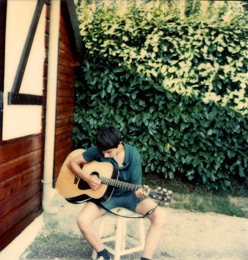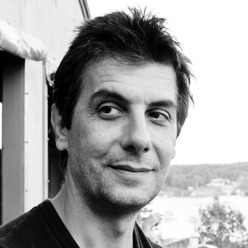

I was born in Paris, France. As far as I can remember my life has been devoted to music. I went on a first tour at age 17. At that time I thought of enrolling at the renowned Mirecourt National School of Luthiery in the Vosges mountains. Life decided otherwise and the next 18 years were spent living as a professional musician. I also taught guitar, privately and in classes, for over 10 years. In the early 1990s I started working as a sound engineer and electronic musician, producing and mixing music for a handful of artists along my own. I moved to New-York City in 1999. Since 2003 I reside with my wife, video artist Virginia Valdes, in the western mountains of Maine.
Early on my love for the guitar led me to study how the instrument is built. In my search for the perfect acoustic steel-string guitar I purchased many vintage instruments and began to restore and resell them. After a few years, still searching and having gained much experience in luthiery, the thought of building my own steel-string acoustic guitar came naturally. This was one of the most fulfilling experiences in my life and a true revelation. I came back full circle to my desire to be a luthier as a young man.
Interviewed by Michael Bashkin for “Luthier on luthier”
Acoustic Guitar magazine “Shoptalk”
Interviewed by Buck Curran for Work & Worry
Interviewed by Terence Tan for Guitarbench
Interviewed by Pamela Chodosh for “The Advertiser Democrat”

I build guitars in my small shop in rural Maine. The building process is done one instrument at a time.
The matching of tonewoods and choice of decoration are highly integrated on every instrument. I make my own rosettes, marquetry and purflings lines, thus each guitar is unique.
My purpose for every instrument is to realise its potential as much as my possibilities allow. I strive for a guitar with a rich sound, yet with great clarity and projection, responding with a wide dynamic range and easy to play and hold.
Aesthetically I shy away from anything that detracts from the beauty of wood and the elegant proportions of the guitar. I aim to build a tasteful instrument of outstanding tone and classic appearance.

The shape of the body, thus the volume of air available for sound production, will determine the basic tone of the guitar. The thickness of the plates, along with the layout, dimensions and individual carving of the supporting braces will refine that basic tone to a great extent and give it life. Further refinements are brought out by scale length and neck dimension. After those decisions are made the choice of tonewoods will bring the instrument closer to an ideal.

My guitars are lightly built and optimised for tone. The top and back are arched rather than radiused, giving thinner plates equal or superior resilience to stress, faster attack and better projection. Being deeper in the centre and shallower on the edges, the guitar is also easier to hold and more comfortable, especially for the right arm.
For smaller models, and when requested for larger guitars, I build in the Martin pre-war style, with an almost flat-top and a spherical compound back. The result is a more enveloping sound for the player with more perceived bass response, in exchange for a small cost in projection, power and response speed.

Laurent Brondel
Phone: (1) 207-418-0098
laurent(at)laurentbrondel(dot)com